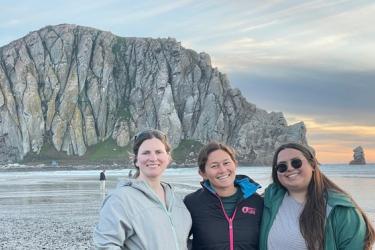The September 2019 Northern California Current Ecosystem Cruise saw warmer sea surface temperature than those found in September of 2018. Overall, phytoplankton abundances were lower, even closer to shore as indicated by both satellite and in situ sampling. Community structure was also different in 2019 than the previous fall. Both microscopy and imaging flow cytometry indicated a greater proportion of dinoflagellates than the expected diatom phytoplankton.

An example of different phytoplankton communities in Sept 2018 and 2019. Diatom dominant phytoplankton community from Coos Bay station in 2018.Large type Psuedo-nitzchia chains look like grains of rice, while Asterionellopsisglacialis and Chaetoceros debilis are in spiral chains. Photo: Tracie Barry.

An example of different phytoplankton communities in Sept 2018 and 2019. The dinoflagellate, Ceratium cf. balechii frequently dominated the phytoplankton community, observed here with Asterionellopsis glacialis and Eucampia zodiacus at Coos Bay station in 2019. Photo:Tracie Barry
For comparison, water was 2 degrees warmer off of Coos Bay, in September 2019 than in September 2018. Chaetoceros diatom species were dominant last year, with the large type domoic acid producing Pseudo-nitzchia species present. This year, the dinoflagellate genus Ceratium, frequently dominated the phytoplankton community and the Pseudo-nitzchia species encountered were typically of the small type. The decreased in Pseudo-nitzchia size and abundance bodes well for upcoming Razor Clam diggers along the coast, as Amnesiac Shellfish Poisoning, caused by domoic acid is unlikely to reach high levels in the near future.
Dinoflagellates and small nano-sized phytoplankton dominated warm water stations (>15 degrees) throughout the survey. Three species of athecate, or naked dinoflagellates were also found, including Nematodinium armatum, Polykrikos kofoidii and a yet unidentified Warnowiid species (possibly Erythropsidinium sp.). Warnowiaceae are notable for their ocelloids, an eye analog. They may also possess nematocysts and pistons, which can be seen pumping in the video, though the function of the piston is unknown. Its relatively uncommon to capture Warnowiids in marine plankton samples, and they remain a poorly understood but fascinating group. Each microscopic encounter garnered excitement from the scientists aboard the Shimada, and all agreed that they are pretty darn incredible for single celled protists. We also encountered Dinophysis tripos, the second largest of the Dinophysis genus, in this stunning flow cytometer image. These two cells were caught just as they were wrapping up reproducing via binary fission, with the two cells still connected at the dorsal megacytic bridge. D. tripos is a warm temperate to tropical species, and we found this incredible specimen in 19 °C water as we were transiting from the Newport line to Crescent City.

MODIS satellite images of SST and chlorophyll concentration from September 2019 along with corresponding phytoplankton assemblages captured by the Imaging Flow Cytobot during the NCC survey. Notice the different communities captured along the Newport Hydrographic Line on September 19th and 25th.
Tracie Barry, Riley Smith (working with Northwest Fisheries Science Center) and Maria Kavanaugh (Seascape Ecology Laboratory, Oregon State University) are working together to investigate the spatial pattern of phytoplankton communities, including HAB species, under different oceanic conditions. Barry and Smith are enumerating and identifying using a tried and true method, microscopy. Kavanaugh takes a broad view of the system, using satellite data and in situ optics to determine spatial variability in habitat types (seascapes), plankton functional types, and taxonomic groups through an Imaging Flow Cytobot. Working together, they can identify species, common and rare, including those that are more regularly found in subtropical environments. To phytoplankton enthusiasts, 2019's unexpected algae diversity offered an opportunity to fully immerse ourselves in researching previously unencountered dinoflagellate species, as well time to ponder the mechanisms of the underlying causes and what they mean for our oceans.

A rare find: The dinoflagellate, Dinophysis tripos, observed dividing. D. tripos distribution is described as subtropical and was observed in an underway sample in transit between NH 200 and CC 150 (offshore). Photo: Maria Kavanaugh
